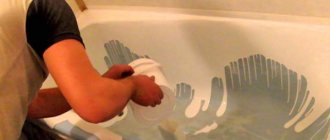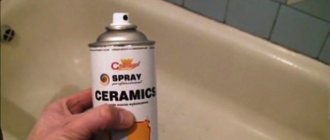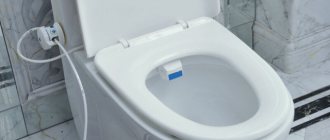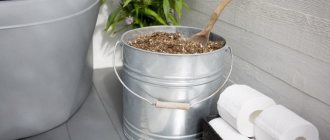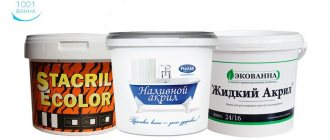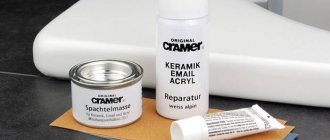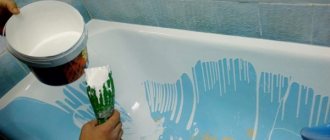Sooner or later, the bathtub, which once delighted the eye with its sparkling whiteness and shine, begins to unpleasantly surprise with its roughness, dirty yellow tint and rust. It’s not a matter of incompetence on the part of the owner; it’s just that the equipment has a certain service life. Over time, the enamel becomes thinner, becomes rough and takes on an unpleasant, indelible tint. In this case, you need to either replace the old plumbing or try to restore it to its previous appearance. In the first option, everything is simple and clear, but in the second, you can install an acrylic liner or apply enamel to restore bathtubs, which is much easier and cheaper to do.
What bath enamels are there?
Manufacturers offer different coatings for bathtub restoration. What requirements must be presented to the paint in order to choose the best option:
- Safety - bath enamel should not contain impurities that can be harmful to health;
- Thermal conductivity - the lower this indicator, the slower the water will cool, respectively, the longer and more comfortable it will be to splash around in the new bathtub;
- Durability - if your task is not to simply add shine, but to solve the problem with bathroom enamel for a long time, then the chosen enamel should be resistant to mechanical and chemical influences.
What enamels for bathroom renovations does the manufacturer offer, and which one is better:
- epoxy - epoxy paint has been used to restore bathtubs for more than two decades. It is a mixture of epoxy resin, fillers and pigments. Refers to two-component enamels that require dilution with a hardener before use;
- acrylic - latex paint, which is based on acrylic, has been conquering consumers for just over ten years. In terms of durability, it is not inferior to epoxy enamels. It is a representative of two-component paints. As a rule, acrylic uses a pouring technique to cover the bathtub;
- alkyd - these water-dispersed compositions do not contain solvents, so they are practically odorless. If the application technology is strictly followed, bath enamel will last about seven years.
Epoxy
Alkyd
Acrylic
Comparative characteristics of bath enamel
To determine which enamel is better, you need to know the pros and cons of each type, as well as how it is applied.
| Dye | pros | Minuses |
| Epoxy | Coating uniformity | Toxicity |
| Resistant to acids and alkalis | Once finished, the paint hardens very quickly. | |
| Does not erase | Possible leaks | |
| Suitable for metal and cast iron | Turns yellow quickly | |
| Acrylic | Maintains a presentable appearance for a long time | Acrylic is toxic |
| Resistance to mechanical damage | High consumption | |
| Low thermal conductivity | Do not use aggressive detergents | |
| Suitable for steel, cast iron, acrylic | Probability of detachment if technology is violated | |
| Alkyd | Non-toxic | Enameling requires careful surface preparation |
| Retains its original appearance for a long time | High consumption | |
| Suitable for all types of coating (including ceramics) | Difficulty of application |
What to pay attention to when restoring enamel plumbing fixtures
In order for the bathtub to last as long as possible after renovation, it is recommended that you pay attention to surface preparation when using any restoration method.
It is recommended to remove small furniture from the bathroom so that it does not become a source of dust accumulation. After all, in the process of leveling the surface there will be a lot of it. It can be cleaned with a vacuum cleaner and water.
To level the surface, our craftsmen use sandpaper. After this, grouts or primers are applied if the product is treated with coloring compounds. Before applying paint, the surface is degreased. With any method of updating the enamel layer, the surface of the plumbing equipment is thoroughly cleaned. The adhesion of paint to the product or adhesive composition when using the technology of applying an acrylic liner depends on this.
Ways to paint a bathtub
To restore bathtub enamel, three main methods are used and everyone decides for themselves which one is better:
- bulk;
- enamelling;
- aerosol.
The pour-in restoration method, at first glance, is one of the simplest. More often it is used to restore a cast iron bathtub. Acrylic is poured onto the sides of the bathtub. Liquid paint flows down, forming a new coating. The pouring technique allows you to correct unevenness, close cracks and make the surface perfectly smooth. But using acrylic without experience or minimal skills is quite problematic. Drips may form.
Pouring technique
Enameling involves using a brush or roller. This method is used to apply enamel and paint. Horizontal strokes alternate with vertical ones to avoid drips. Without waiting for the enamel to dry, apply the second and then subsequent layers.
Painting a bathtub with enamel
The aerosol method is really the simplest. Spray paint does not need to be pre-prepared. It is possible to immediately choose the appropriate color. Before use, shake the can well for two to three minutes.
Aerosol use
An alternative way to update your bathtub is to install an acrylic liner. Particularly suitable for restoring an old cast iron bathtub. This coating is installed using glue. The method is fast, simple and effective. The only difficulty is in caring for acrylic. He does not like aggressive cleaning agents and is sensitive to mechanical damage.
Acrylic liner
Review of popular manufacturers
There are not many proven and reliable products that can be used when restoring bathtubs. The thing is that most companies, during production, use compounds that are not suitable for carrying out restoration work to restore the bathtub. In addition, most products from different manufacturers differ in composition. It is the composition of the enamel restoration product that affects the method of its application and the amount of time required for it to dry.
Epoksin 51 or Epoksin 51C are excellent for restoring the enamel coating. Random House products also performed excellently when restoring damaged enamel and restoring bathtubs. It is worth noting that Random House is a domestic manufacturer, which is represented on the market by such best bathroom enamels as Fantasia and Svetlana.
How to choose enamel
The coating to restore the bathtub to its former beauty is selected according to three criteria: application method, completeness and color. The application method - poured acrylic, aerosol or enamel - will depend on the degree of damage to the old enamel, the financial capabilities and skills of the artist. You can purchase all the necessary products separately. Some manufacturers produce bathroom enamel complete with a hardener, tinting paste, solvent and everything necessary for the preparation and process of refinishing the coating.
Using tinting paste, you can create any shade when restoring an old bathtub. It depends only on the taste, as well as the preferences of the owner. When purchasing two-component paint, you need to pay attention to the color of the hardener. A transparent, translucent or gray shade is better - the enamel component will not be noticeable after restoration. More saturated shades may leave spots and streaks.
Not only the final appearance, but also the durability and strength of the coating depends on the correct choice of enamel for bathtub restoration.
Aerosol enamel, advantages and disadvantages
The aerosol technique is one of the easiest ways to update a bathtub. When choosing this option to revive the coating, you need to consider the pros and cons of such paint.
Advantages of spray paint:
- it dries quickly (a few hours is enough);
- no additional tools needed;
- aerosol enamel fits better on the surface and has good adhesion, that is, it adheres tightly;
- a varied assortment: cans can contain two-component paints, acrylic, and so on;
- easy application.
Bath enamel in a can
Disadvantages of aerosol enamels:
- difficult to use to restore large surfaces: certain skills are required to avoid uneven tone and drips;
- the layer turns out thin, since the composition of the aerosol paint includes a large percentage of solvent;
- fragility: a thin coating cannot guarantee a long service life of a new bathtub.
Using this technique, it is easy to restore an old cast-iron bathtub or make minor repairs to an acrylic bathtub.
Conventional enameling
Plumbing bowls made of cast iron and steel enameled products are very common. They are manufactured according to GOST-18297-96. Service life according to GOST is 2 years. The enamel remains on the surface for up to 10 years. At the factory, they are coated with enamel by heating the bowl until red-hot. Then enamel powder is poured into the bowl and wait until the powder sinteres with the metal. The surface is then heated again to spread the coloring powder. The result is a smooth, glossy, enameled coating.
You can’t do this at home, let’s see how to restore bathtub enamel yourself. What will be needed for restoration work? Restoration requires the use of consumables and tools:
- drill with grinding wheel;
- abrasive powder;
- emery;
- rust converter;
- degreaser;
- lint-free wipes;
- natural brushes or spray bottle;
- individual protection means;
- two-component enamel.
Preparatory process
It is worth remembering that preparation is an important stage. The better the preparatory work is done, the better the enamel layer of the updated bowl will be. The process includes the following steps:
1. The old coating is sprinkled with abrasive powder and cleaned off with sandpaper or a drill.
2. The rusty areas are treated - a rust converter is used.
3. Abrasives and enamel are washed off with water. The surface is thoroughly degreased and wiped with napkins.
4. Fill the bowl with hot water and let it sit for about 10 minutes. The water is drained and wiped dry.
Applying enamel
To restore an enameled or cast iron bathtub with your own hands, mix the enamel and hardener and stir the mixture. The first layer is applied with a brush or spray. Then a second layer of coating is applied and leveled with a roller. This way we restore the condition and appearance of the bowl.
Types of aerosol paints
The modern market offers a large selection of aerosol enamels for baths and ceramics. Almost every manufacturer tries to produce bath paint in several formats, including aerosols or sprays.
Spray paint WHITEST New Ton
Aerosol New Ton is a Ukrainian epoxy-based bath enamel. The paint dries quickly and has excellent adhesion to enamel surfaces, which is especially necessary for restoration, for example, of an old cast-iron bathtub. The enamel is presented only in snow-white form. The volume of the can is 400 ml. Shelf life: 3 years. Cost – from 200 rubles per can.
It is important that New Ton provides a reliable coating with resistance to temperatures up to 100 degrees. The enamel does not peel off or crack. There is no need to prime the surface before applying New Ton. One layer dries in 6 hours, a completely multi-layer coating will dry in two days.
Enamel WHITEST New Ton
Enamel spray for baths and ceramics Kudo
Aerosol for baths and ceramics Kudo is a Russian alkyd-based enamel. Quick drying (no more than 5 hours), excellent adhesion to various materials made this paint very popular. Other positive qualities include temperature resistance and high hiding power. The shelf life is 5 years, and you will have to pay a little more than 200 rubles for a can.
Color – white – can volume 520 ml. This is enough to treat about 2 square meters of surface (in one layer). Dry for 10-15 minutes between coats. Complete drying of the treated surface is achieved after 24 hours. You can use the bath for its intended purpose after three days.
Enamel aerosol Kudo
Epoxy enamel DECORIX
DECORIX epoxy enamel made in China gives a snow-white glossy finish as a result of painting. The paint is resistant to mechanical damage (cracks, scratches), temperature changes, and fading. DECORIX enamel dries quickly and has good adhesion to various materials. The cost of a 520 ml can starts from 250 rubles.
Epoxy enamel DECORIX
Spray CHAMPION COLOR
CHAMPION COLOR is a Polish epoxy-based aerosol enamel. Suitable for various metals, ceramics, plastics. White color. The enamel has high gloss and good adhesion. The drying time of the layer is from one hour, while the manufacturer advises applying the enamel in a layer of 25 mm or more. After 72 hours, you can fully use the bath – the coating has completely dried and acquired all its properties. The shelf life is 5 years.
The volume of the can is 400 ml. This is enough to cover two square meters of area. Before use, shake the can about 30 times to thoroughly mix all the ingredients.
Spray CHAMPION COLOR
The first thing you need to do to understand whether you can get by with “little loss,” that is, with low material investments, is to assess the degree of wear and tear of the bathtub. If deep cracks or even chips appear on an enamel bathtub, then special work must be carried out. A bathtub is subject to restoration if:
- the enamel has turned yellow and faded;
- shallow cracks are noticeable;
- the coating became loose.
Throw it away or re-enamel it? If you are still asking yourself this question, weigh the pros and cons. Replacing a bathtub will require significant financial investment and is more appropriate in the case of a major renovation. Spray enamel can easily cope with small cracks and loss of shine. It does not need to be prepared, diluted with a hardener, solvent or color. Applying a completely finished product will save effort and money. In a few hours, the most worn-out cast iron bathtub will shine with its pristine beauty.
Polishing instructions
Stains from an enamel bathtub will disappear if you rub it with toothpaste.
- The bathtub should be cleaned with a sponge soaked in water and a small amount of detergent. It is not recommended to use products with abrasive components, formaldehyde (formic acid), ammonia, or washing powder. Such detergents may cause the surface to become dull.
- The detergent is evenly applied to the surface of the bath for 10 minutes. After this time, the surface is wiped with a damp sponge and rinsed with water. If the contamination is quite strong, the procedure will have to be repeated.
- Wax polish is applied to the walls and bottom of the bathtub and gently rubbed with a soft cloth.
- Stubborn stains can be removed from the enamel using detergents, toothpaste or silver polishing. Apply a small amount of any of these products to a soft cloth and rub the stain.
- Scale stains can be removed with lemon juice or vinegar.
- The aerosol is sprayed onto chrome parts and washed off with a stream of water, then wiped dry.
- To remove small scratches from the enamel, the acrylic bath is washed, the scratch is treated with sandpaper, then an abrasive polish is used, and lastly, a wax polish.
Hydromassage bath
To keep your hot tub clean, it is recommended to do a deep cleaning once a week.
To polish a hot tub, you need:
- Fill the bathtub with warm water with detergent dissolved in it. Run the hydromassage system for 5 minutes. After turning off, leave the water in the bowl for another 10 minutes. After that, drain the water.
- Fill the bowl with clean water again and turn on the hydromassage for 5 minutes to rinse the bath. Drain the water and continue polishing in the previously described order.
The entire work of updating the enamel will take about 3 hours, and the result will last for 10 years. During the polishing process, a layer of acrylic about 0.2 mm thick is removed from the surface. This will have virtually no effect on strength, since the bathtub is 7 mm thick.
